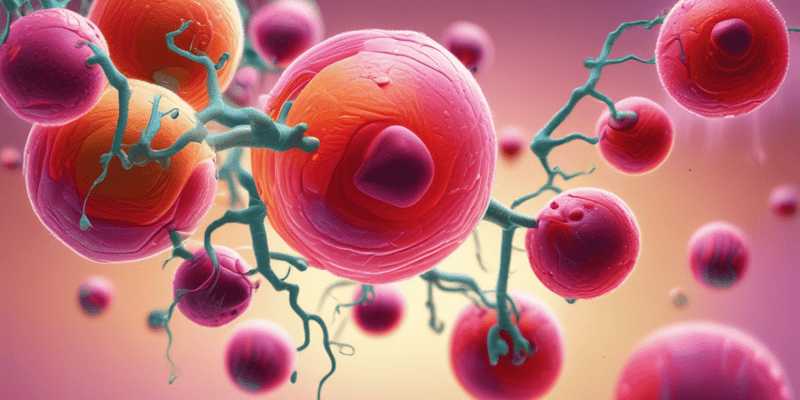Podcast
Questions and Answers
In which reactions does Pyridoxal phosphate (PLP) participate?
In which reactions does Pyridoxal phosphate (PLP) participate?
What is the role of Pyridoxal phosphate (PLP) in amino acid metabolism?
What is the role of Pyridoxal phosphate (PLP) in amino acid metabolism?
What is the recommended dietary allowance (RDA) of pyridoxine for an adult?
What is the recommended dietary allowance (RDA) of pyridoxine for an adult?
How does Pyridoxine integrate carbohydrate and amino acid metabolisms?
How does Pyridoxine integrate carbohydrate and amino acid metabolisms?
Signup and view all the answers
What is the role of Pyridoxine in the metabolism of certain specialized products?
What is the role of Pyridoxine in the metabolism of certain specialized products?
Signup and view all the answers
What is the role of Pyridoxal phosphate in the transamination reaction?
What is the role of Pyridoxal phosphate in the transamination reaction?
Signup and view all the answers
How does the intake of pyridoxine change during pregnancy, lactation, and old age?
How does the intake of pyridoxine change during pregnancy, lactation, and old age?
Signup and view all the answers
What are some of the reactions in which Pyridoxal phosphate (PLP) participates?
What are some of the reactions in which Pyridoxal phosphate (PLP) participates?
Signup and view all the answers
What specialized products are dependent on pyridoxine for their synthesis?
What specialized products are dependent on pyridoxine for their synthesis?
Signup and view all the answers
How does Pyridoxine contribute to metabolism?
How does Pyridoxine contribute to metabolism?
Signup and view all the answers
Study Notes
Pyridoxal Phosphate (PLP) Reactions
- PLP participates in various reactions, including transamination, decarboxylation, and deamination of amino acids.
- It also plays a role in the synthesis of neurotransmitters, such as serotonin and dopamine.
Role of PLP in Amino Acid Metabolism
- PLP acts as a coenzyme in amino acid metabolism, facilitating the conversion of amino acids into other amino acids, carbohydrates, or fatty acids.
- It helps break down amino acids into alpha-keto acids, which can then be used for energy production or glucose synthesis.
Recommended Dietary Allowance (RDA) of Pyridoxine
- The recommended daily intake of pyridoxine is 1.3-1.5 mg for adult men and 1.1-1.3 mg for adult women.
Integration of Carbohydrate and Amino Acid Metabolisms
- Pyridoxine helps integrate carbohydrate and amino acid metabolisms by facilitating the conversion of amino acids into glucose or glycogen.
Role of Pyridoxine in Specialized Product Metabolism
- Pyridoxine is necessary for the synthesis of certain specialized products, such as neurotransmitters, hormones, and antioxidants.
- It plays a role in the metabolism of sulfur-containing amino acids, such as cysteine and methionine.
Transamination Reaction
- PLP is involved in the transamination reaction, which allows for the transfer of amino groups between amino acids and alpha-keto acids.
Pyridoxine Intake Changes
- The recommended daily intake of pyridoxine increases during pregnancy (1.9-2.0 mg) and lactation (2.0 mg), and decreases with old age (1.5-1.7 mg).
Contribution to Metabolism
- Pyridoxine is essential for the metabolism of amino acids, carbohydrates, and fats, and plays a crucial role in maintaining overall health and well-being.
Studying That Suits You
Use AI to generate personalized quizzes and flashcards to suit your learning preferences.
Description
Test your knowledge of the biochemical functions of pyridoxal phosphate (PLP), the coenzyme of vitamin B6. Learn about its role in the metabolism of amino acids and its participation in reactions like transamination, decarboxylation, and condensation.




